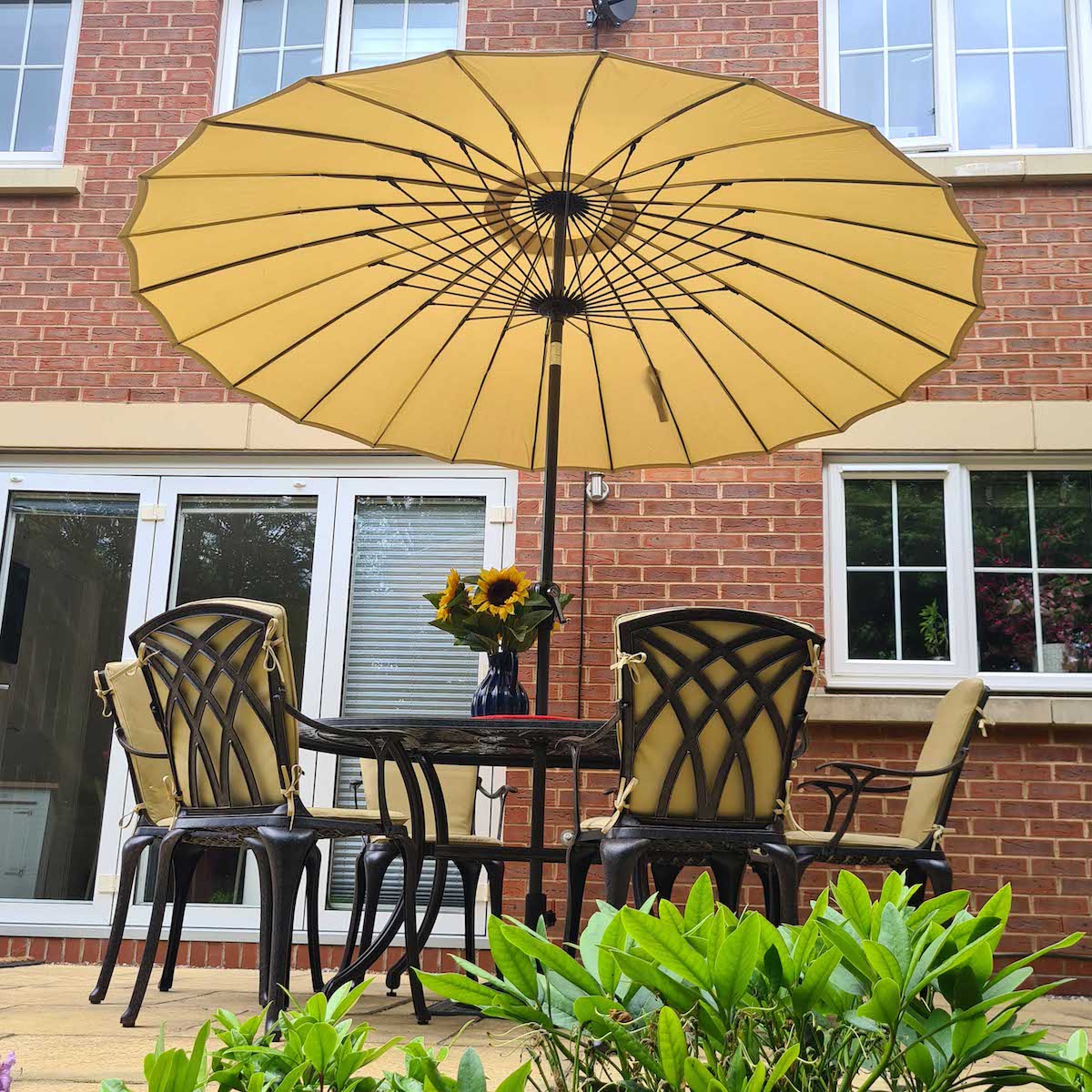A garden Parasol or retractable patio awning are both great ways to keep you cool and protect you (and anything you put on your outdoor table such as food and drinks) from the hot summer sun.
The size and shape of garden parasols and awnings often makes them difficult to clean but we always advise that you tackle the job in place, fixed on their frame or support arms, and fully opened up or extended.
Removing the fabric to clean is also a big no-no. In fact, it is often designed not to be removed (as is the case with our Parasols) as the fabric could shrink or lose its shape.
Opening it up so the fabric is stretched out makes it quick and simple to wash down and rinse off. And with a parasol like ours, the job is made even easier, as you can simply drop it down and tilt the canopy.
With an awning they are often a little higher up, so we would recommend you use a step ladder if safe to do so (i.e. with somebody to help support you) or a long-handled soft bristle brush and garden hose if not.
And before we jump into our preferred cleaning methods and solutions, it is also worth highlighting that we would not advise you to use a pressure washer on your parasol or awning. Even on their lowest setting, you could still rip the fabric or strip colour from it!
Now that we’ve got a few important "don’ts" out the way, we should probably give you the lowdown on what are our parasols made from and the actual "do’s" of safely and effectively cleaning garden parasols and awnings.
What are our parasols made from?
At Lazy Susan, our Parasol collection is made from an easy-care acrylic fabric that can be wiped clean to keep it looking as good as new. If you don’t have one of our parasols then it will be generally made from the same fabric or a polyester blend fabric.
We decided to use acrylic canvas on our parasols for a number of reasons:
- Acrylic fabrics dry quickly and give excellent shower resistance.
- Acrylic canvas fibres are more flexible than polyester so it maintains shape and will not shrink.
- Acrylic fabric offers a higher level of UV protection than polyester fabrics. They are 50 UPF+ (Ultraviolet Protection Factor), which is the maximum protection factor.
- Acrylic fabrics are very difficult to tear and offer excellent wind resistance.
- Acrylic fabrics offer much better mould and mildew resistance and are less likely to stain than polyesters.
The parasol pole is made from the same cast aluminium as our garden tables and chairs combined with flexible fibreglass for the inner ribs of the umbrella. This gives them rigid strength but flexibility where it is needed. It also keeps the weight down for ease of lifting and setting up.
Our parasols also feature a crank handle for easy opening and closing and the pole can be tilted to angle the umbrella for better shade as the sun sets.
Our parasol bases, on the other hand, are constructed from a heavyweight cast iron, designed to keep them in place if the wind picks up.
How do you clean our parasols?
The acrylic canvas on our parasols is fast-drying, shower-proof and highly UV-resistant but to maintain those qualities, it needs the correct care and maintenance.
Light regular cleaning is the solution as this will help to stop dirt and grime from building up. Our go-to method for a quick regular clean of the acrylic canvas is as follows but this method is also great for polyester parasols too:
- Hoover your parasol
The fabric of your parasol can get pretty dusty, especially if left outside in the summer. So, making sure it is dry, give the fabric a hoover with the soft brush attachment to get rid of any surface dirt and dust. Don't rub it too hard with the brush as you could damage the fibres. Just a light once-over will suffice. - Keep the water lukewarm
Acrylic canvas and polyester can shrink in hot water so our advice is to stick to lukewarm only. If you can’t put your hand in it, then it is too hot. Keeping the water lukewarm or even cold will prevent you from damaging the colour and finish of the canvas too. - Wash your parasol umbrella
We generally use a little bit of laundry detergent but washing up liquid works too. You tend to find that laundry detergent is tougher on stains and it smells better. Just mix 1/4 of a cup into the bucket of lukewarm water. Then with a soft-bristle brush or microfibre cloth, wash down the parasol canvas, on both sides. - Leave the fabric to soak
When all done, leave it to sit on the canvas and get to work for about 10 minutes. Don’t let it dry out, just leave it long enough to soften any dirt and grime. Move on to step 5 and when that is done, enough time has usually passed. - Wash the base, pole and fibreglass ribs
For the parasol framework and pole, you can simply clean them in the same way we clean our furniture, with a little car shampoo and some warm water. With the parasol still up and open, wash it all down with a soft sponge or a microfibre cloth. - Rinse your parasol
Once step 5 is done and the fabric has had a good soak, you can rinse it all down. The key is to get all that soap off the canvas. We will use the garden hose (as per our intro, never a pressure washer) on a light spray/mist setting. Alternatively, you could use a bucket of cold water and pour it on to rinse but it might take a few trips to the tap. - Dry your parasol
Once rinsed, blot the canvas with a clean dry towel. Dry the frame with another clean towel and then leave it open and in the sun to fully dry. Do not close the parasol or put it away until the fabric is completely dry as this is what can encourage mould growth. - Protect your parasol
To further protect our parasol we like to apply a little extra protection with some Scotchgard Water & Sun Shield. For the frame, a light coat of car wax applied with a microfibre cloth with give it a nice sheen and keep it a little cleaner for longer. - Apply a little WD-40
For any moving parts such as the tilt mech and crank handle, carefully apply a little bit of WD-40 but make sure you wipe away any excess, watch for overspray and avoid any contact with the fabric. - Store your parasol
When not in use, always store your parasol somewhere clean and dry. If you want to leave it outside during the summer months, then invest in a parasol cover.
To remove more stubborn staining such as mould and mildew spots, please see the section below for our cleaning method.
How do you clean a garden awning?
Awnings can be cleaned in much the same way as a parasol but their fixed position and size make them a little more tricky than a parasol. For that reason, we would recommend that you clean them at the start and end of summer and keep them retracted/rolled up when not in use.
During the summer, to prevent too much dirt from building up, open them and give them a regular rinse with the garden hose. Again, never use a pressure washer, you just want a light spray to gently remove dust and debris. Then leave them open to dry in the sun.
Our preferred method for giving an awning a start/end of summer clean is as follows:
- Brush your awning
Getting the vacuum cleaner high enough can be a little tricky, so the best solution is to give it a brush before you wash it. Open it fully and with a soft bristle long handle brush, remove all the loose dust and debris. - Keep the water lukewarm
Most good awnings are also made from acrylic canvas and this is also the common choice for the commercial awnings you’ll see installed above shops, cafes, etc too. So as with our parasols, use lukewarm water only to clean, and this will prevent you from damaging the colour/finish of the canvas. - Wash your awning
Again, laundry detergent is the best option but washing up liquid will also work. As with a parasol, mix 1/4 of a cup into a bucket of lukewarm water. Then with a soft-bristle brush or microfibre cloth, wash down the canvas on your awning. - Leave it to soak
When washed, leave it to sit on the canvas for about 10 minutes. Don’t let it dry out, just leave it long enough to soften any tougher dirt and grime. Move on to step 5 and when that is done, enough time has usually passed. - Wash the frame, rails and housing
For the awning hardware, you can simply clean them in the same way we clean our parasols, with a little car shampoo and warm water. With the awning still fully extended, carefully wash it all down with a soft sponge or a microfibre cloth. - Rinse your awning
Once the last step is done and the awning canvas has had a good soak, then you can rinse it all down. The key is to get all that soap off, so a garden hose (as per our intro, never a pressure washer) on a light spray/mist setting is the best solution. A bucket can be a little tricky to pour over so as an alternative if you can’t use a hose a clean mop and cold water can be used too. - Dry your awning
Blot the canvas with a clean dry towel to remove any excess and dry the frame with another clean towel. Leave it fully extended and in the sun to dry. As with our parasols, do not retract the awning until the fabric is completely dry as this can encourage mould growth. - Protect your awning
To further protect your awning, you can also apply a little extra protection with some Scotchgard Heavy Duty Water Shield. For the metal framework, a light coat of car wax applied with a microfibre cloth with give it a nice sheen and keep it a little cleaner for longer. - Apply a little WD-40
For any mechanical parts such as the drive arms and rails, you carefully apply a little bit of WD-40 but make sure you wipe away any access and avoid contact with the fabric. Always follow manufacturers' guidelines with regard to this step. - Store your awning
When not in use, always retract your awning to keep it clean. If it gets wet, as per step 7, always ensure it is dry before you close it.
How do you safely remove mould and mildew from outdoor fabrics?
If you do find that mould and mildew have formed on your awning or parasol canvas, then depending on how long it has been there, it can be tricky to remove the stains on lighter-coloured fabrics.
That said, you have a couple of options you should definitely try before you replace them with a new one.
First up, you can try a proprietary cleaner such as Astonish Mould & Mildew Blaster. It contains biocides and is pretty powerful stuff so always follow instructions - test on the fabric first, wear protection and work somewhere safe and away from lawns, plants, etc.
If you want to try a non-bleach/biocide method that’s a little safer, then we’ve had success cleaning mould and mildew of parasol canvas with the following method:
- Brush the fabric
Start by giving the canvas a good brush with a soft-bristle brush to remove any loose dirt from the material. - Wipe the fabric
Wipe the fabric with a damp soft cloth to remove any remaining dust and debris. - Mix up a solution with white vinegar
With rubber gloves on, mix up 1/4 of a cup of laundry detergent and 2 cups of distilled white vinegar in a bucket of lukewarm water. - Wash the fabric
Using the soft cloth or sponge, wipe the parasol gently with the solution and gently scrub any mould or mildew spots with a soft bristle brush until it's all gone. - Rinse with cold water
Then rinse the bucket and refill it with cold water. - Blot the fabric with a sponge
With a clean sponge carefully rinse the solution off the fabric. You might need to do this a couple of times and replace the water but this way you will remove the solution without rinsing it onto your garden or patio. - Rinse the fabric again
Then when you’ve sponged it off, give it a good rinse with the garden hose on a light spray/mist setting. - Leave the fabric to dry
Leave it to air dry outside or in the sun and hopefully, it is looking as good as new.
If you have your Garden Furniture under a parasol or awning, then we’d love to see a few snaps for our Do Some Good charity campaign. You can tag us @LazySusanFurniture on Instagram or Facebook or email them to us at [email protected].







